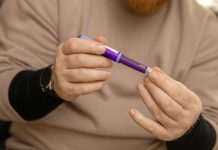
A stark revelation from a recent study unveils that nearly 10 million Americans stand on the precipice of blindness due to diabetic retinopathy, throwing a spotlight on a burgeoning health crisis.
In 2021, 26% of U.S. citizens with diabetes, approximately 9.6 million individuals, wrestled with this eye condition, with almost 2 million grappling with its most severe form, vision-threatening diabetic retinopathy (VTDR).
This demonstrates a clear, urgent call to prioritize eye care and diabetic retinopathy screening among those with diabetes.
Unmasking the Intricacies of Diabetic Retinopathy
Dr. Talia Kaden, an ophthalmologist at the Manhattan Eye, Ear and Throat Hospital, elucidates that diabetic retinopathy wreaks havoc on the small blood vessels in the eyes.
This can translate into a cascade of issues like damage and abnormalities in small vessels, loss of blood supply to essential eye parts, swelling, bleeding, and formation of anomalous blood vessels. The outcome, if left unchecked, cascades into vision loss.
Tackling the Prevalence and Demographics
Data from the U.S. Centers for Disease Control and Prevention’s Vision and Eye Health Surveillance System underscored the gravitas of the situation.
Notably, the prevalence of VTDR demonstrated racial disparities, with Black (9%) and Hispanic (7%) populations facing higher prevalence compared to white individuals (4%).
Such disparities hint towards the interplay of negative social determinants of health, like poverty and healthcare access, spiraling into higher diabetes rates and its complications.
Geographical Disparities and Age-related Dynamics
The prevalence of diabetic retinopathy oscillated from state to state, dipping to 21% in Nevada and peaking at 34% in Hawaii, with the highest prevalence notably occurring in impoverished areas, particularly in the Deep South.
Although prevalence generally increased with age, a notable decline was observed in older demographics.
Researchers postulate that this could be attributed to these eye conditions signaling severe diabetes, potentially leading to premature mortality.
Prioritizing Screening and Early Intervention
David Rein, a senior fellow and director of the Public Health Analytics Program at NORC at the University of Chicago, and Dr. Kaden emphatically advocate for rigorous screening and early intervention as linchpins in preserving vision among diabetics.
Dr. Kaden underscores, “Every diabetic really should be seen by an ophthalmologist annually,” with follow-up frequencies fluctuating based on the individual’s condition from yearly to monthly.
Unveiling Potential Treatments
A glimmer of hope resides in existing effective treatments, especially for swelling and sometimes for bleeding in the eye’s rear, involving injections and medications.
Lasers also enter the therapeutic arsenal, aimed at thwarting the formation of abnormal blood vessels and consequent bleeding.
Elevating the Emphasis on Preventing Diabetic Eye Disease
In an accompanying editorial to the study, which was published online on June 15 in JAMA Ophthalmology, Xiangrong Kong, an associate professor at the Wilmer Eye Institute, stressed that diabetic eye disease must ascend to a paramount position within diabetes care.
Both patients and healthcare providers must forge a proactive stance to preclude blindness, underscoring the imperative that eye care to prevent vision loss and blindness should neither be sidelined by patients, their healthcare providers, nor by health policymakers.
If you care about diabetes, please read studies about a cure for type 2 diabetes, and these vegetables could protect against kidney damage in diabetes.
For more information about diabetes, please see recent studies about bone drug that could lower risk of type 2 diabetes, and results showing eating more eggs linked to higher risk of type 2 diabetes.
The research findings can be found in JAMA Ophthalmology.
Follow us on Twitter for more articles about this topic.
Copyright © 2023 Knowridge Science Report. All rights reserved.



